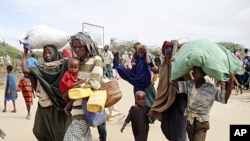While the international aid community tries to help the Horn of Africa’s 10 million vulnerable drought victims, long-term solutions to avoid such humanitarian disasters are once again being scrutinized.
A senior research fellow with the International Food Policy Research Institute, John Hoddinott, gives a blunt assessment on how international aid agencies react to disasters such as the one taking place in the eastern Horn of Africa.
“I think what these agencies find difficult is getting the balance right between sort of saying that we may have a crisis occurring and saying the crisis is now upon us," he said. "Understandably, they do not want to raise false alarms but that does mean that by the time it penetrates the consciousness of Western governments, for example, the crisis is often fairly well advanced.”
A professor at Princeton University, Eric Wood, is currently working with the United Nations Educational, Scientific and Cultural Organization, known as UNESCO, to roll out drought monitoring and forecasting across Africa to raise accurate alarms sooner.
“We use high resolution, hydrologic models with remote sensing data. We are in the process of assessing, improving and transferring that to UNESCO," said Wood. "I would say that with our abilities to do this and the abilities of having users in Africa our hope is that through web services, using the Internet, they will be able to see what is happening and relate it to maybe some more detailed data that they may have locally that is not available on a pan-African basis.”
There is also a new European Union project called DEWFORA, also known by its longer name, Improved Drought Early Warning and Forecasting to strengthen preparedness and adaptation to droughts in Africa.
The U.S. government has its own organization called FEWS NET, short for Famine Early Warning Systems Network. It was set up following the 1984 to 1985 famines in Sudan and Ethiopia with an emphasis on trying to ensure continued food security in vulnerable areas.
FEWS NET program manager John Scicchitano says he believes the more similar organizations there are, the more information there will be to spur early action.
“I think it is useful to have some separate monitoring of these situations that we can begin to converge evidence and then come to a common decision," he said. "Each unit or each organization can contribute its own information and as much as we can piece that information together, we can come up with a solid body of evidence to inform decision-making.”
But many currently frustrated development experts say information is not what is missing, and that the warnings about the potential effects of this drought started last year.
Some of the experts say that like with all good ideas, including improving agricultural crops in vulnerable areas, the necessary money and follow through is often lacking.
Hoddinott, the researcher with the International Food Policy Research Institute, has been more encouraged by a slowly expanding initiative in Ethiopia called the Productive Safety Net Program.
“The idea behind this program is to move away from ad-hoc relief efforts and to put in place a permanent safety net which gives people access for example to employment in exchange for working on public works but does so on a predictable and reliable basis,” said Hoddinott.
The program combines social protection with agricultural support, such as cash or food in exchange for working on community water conservation projects.
Hoddinott says droughts are clearly not going away, and he would like to see the program expanded in Ethiopia and elsewhere.
“We are certainly going to see them in the future and what that suggests certainly to governments and policymakers is thinking about how to respond in a pro-active way, putting planning processes in place, perhaps putting programs in place that you can scale up in response to these shocks, rather than continually waiting for them to occur and then trying to scramble to come up with a response to the extent to which governments can be forward looking. They can’t make rain fall from the skies but they can certainly improve the responses that exist to shocks such as droughts,” said Hoddinott.
In the meantime in the Horn of Africa, extremely high levels of child malnutrition are being reported in multiple locations, many of them with very little infrastructure.
The drought is mostly affecting already marginalized or conflict displaced populations in Somalia, Kenya, Ethiopia and Djibouti.
Aid coordinators say they expect the worst is still to come, after two years of failing rains. The next rains, if they do come, are not expected until October, with the next substantial crops coming at the earliest next year.
Experts Look to Forecasting, Safety Nets to Avoid Future Drought Disasters in Horn of Africa














